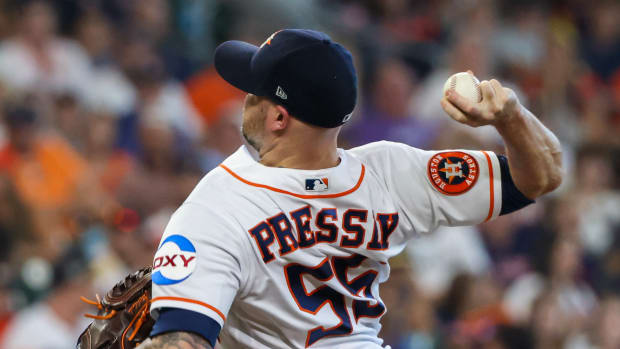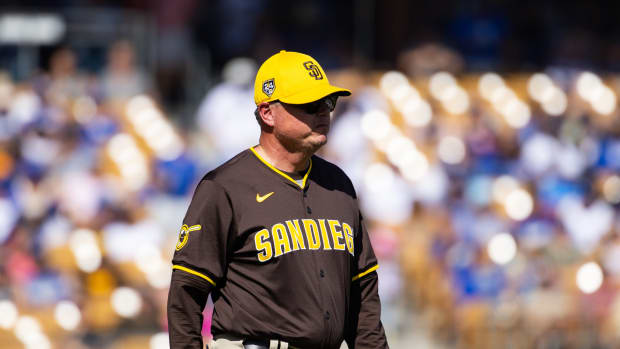Sticky Cleanup: What Pitch-Doctoring Enforcement Means for MLB
Welcome to The Opener, where every weekday morning you’ll get a fresh, topical column to start your day from one of SI.com’s MLB writers.
The Great Cleanup has begun. In advance of an MLB crackdown on doctoring baseballs, four-seam fastball spin rate is declining and offense is picking up.
After 10 consecutive weeks when MLB average four-seam spin rate hovered between 2,306 rpms to 2,329 rpms, last week it suddenly dropped 45 rpms to a season-low 2,269. Batting average against four-seamers is up 11 points in June. Slugging against the pitch is up 18 points this month.

Dodgers righthander Trevor Bauer's four-seam fastball's spin rate has dropped 210 rpms since June 3.
Ron Chenoy/USA TODAY Sports
Variation in individual spin rate is not by itself proof of violating baseball rules. Among pitchers who hit two-year lows in fastball or cutter spin rate last week were Trevor Bauer of the Dodgers, Gerrit Cole and Aroldis Chapman of the Yankees, Freddy Peralta and Corbin Burnes of the Brewers, and Lucas Sims of the Reds. On Sunday Shane Bieber of Cleveland saw a 98-rpm drop in his spin rate while giving up a two-year high five runs to Seattle, the worst hitting team in history (.209). (After this story was published, Cleveland placed Bieber on the injured list with a right-shoulder strain.)
The sudden decline in MLB spin rate came during an unofficial two-week transition window between a warning MLB gave pitchers to clean up their act and enforcement that is expected to begin this week. In coming days umpires will be instructed to enforce Official Baseball Rule 3.01 more vigorously. The rule bans the application of any foreign substance to the baseball. Rule 6.02 (c) expands on the rule to bar having any such substance “on his person, or in possession.” In recent years umpires operated under general instructions only to intervene when prompted by opposing managers, which has not happened in the past six years because every manager has pitchers on his team who are cheating.
The warning followed two less-than-robust attempts by MLB to curtail cheating. On Feb. 28, 2020—just three days before the Los Angeles Angels fired visiting clubhouse attendant Brian Harkins for providing performance-enhancing grip aids to pitchers—MLB issued a memo to managers and club officials noting that the doctoring of baseballs violated rules. This spring officials repeated those warnings and announced three measures designed to discourage the practice: game-day compliance officers near the field, the random removal of baseballs for inspection and the monitoring of individual fastball spin rates to flag suspicious increases.
“In every case a pitcher would ask his pitching coach, ‘Does this mean they’re cracking down?’ ” a high-placed MLB source says. “And the answer was always, ‘No. Keep on doing what you’re doing.’ You can’t change behavior without enforcement.”
MLB did collect dozens of baseballs slathered with sticky substances by pitchers to make the ball spin faster. Its monitoring of spin rates did find four-seam spin rates rising for a fourth consecutive year. (Unlike breaking pitches, four-seam spin rates should remain relatively stable without the use of sticky stuff.)
“We went through the evidentiary period,” says another league source. “We have all the evidence we need.”
The warning, evidentiary and transition periods lead to a fourth phase that starts now: enforcement. The crackdown plan was presented to owners at a meeting June 3 and widely reported in various media. The publicity already has had a desired effect: getting pitchers to clean up their act and to restore some offense to a sport with fewer hits per game (15.7) than all but one season in baseball history, 1908, smack in the Deadball Era. Offense against four-seamers is on the rise:
MLB Four-Seam Fastballs by Month
| RPM | Avg. | SLG | |
|---|---|---|---|
April | 2,313 | .248 | .437 |
May | 2,324 | .248 | .442 |
June | 2,290 | .259 | .460 |
*Lowest since Aug. 2019
Four-seam spin rate can fluctuate slightly in relation to factors such as arm health and velocity. Jacob deGrom of the Mets, for instance, in 2020 gained 1.7 mph and 88 rpms on his fastball. (This year he has added 0.6 mph and lost 52 rpms.) Among noticeable drops in fastball spin rate since June 3 are those of Bauer (-210), Burnes (-163), Sims (-117), Cole (-92), Chapman (-72), Peralta (-69) and Bieber (-50).

The spin rate of Brewers righthander Corbin Burnes's four-seam fastball has decreased by 163 rpms since June 3.
Jeff Hanisch/USA TODAY Sports
Pitch doctoring has followed the same arc as PEDs: It spreads because it works—and those who cheat find silly rationalizations that insult any modicum of intelligence. The trope for pitch doctoring is “the baseballs are slick and hitters want us to have a good grip.” That may have been true when pitchers used a dab of pine tar. But the practice, like PED use, has grown into a highly scientific practice not for safety reasons but for performance enhancement.
As Bauer tweeted in 2018, “The rules should be enforced as they’re written. Pine tar is more of a competitive advantage in a given game than steroids are.”
Why do pitchers cheat? To spin the ball faster to make it more difficult to hit. There is a direct correlation between how fast a baseball spins and how hard it is to hit. Every 100 rpms added to a four-seam fastball takes about 10 points off batting average and 18 points off slugging:
Four-Seam Fastballs by Spin Rate, MLB 2021
| RPM | Avg. | SLG |
|---|---|---|
<2,000 | .295 | .518 |
2,000-2,199 | .273 | .474 |
2,200-2,399 | .253 | .451 |
2,400-2,599 | .231 | .417 |
2,600-2,799 | .217 | .374 |
>2,800 | .144 | .259 |
Here is how it happens: spin is a gravity fighter. The more a four-seam fastball spins with its true backspin direction, the more it fights gravity. A hitter learns from tens of thousands of pitches where he expects the ball to be based on its speed and trajectory. But a super-spinning fastball—say, 2,700 rpms and above—fools the hitter because it doesn’t sink as much as those thousands of fastballs he has cataloged in his head. That’s why you see hitters swinging underneath high-spinning fastballs.
You can use Bauer as an example as well. Note that spin rate depresses offense more than velocity:
Bauer Four-Seam Fastball by Spin Rate, 2016-21
| RPMs | Avg. | SLG | MPH |
|---|---|---|---|
2,699 and less | .275 | .486 | 94.3 |
2,700+ | .152 | .333 | 93.8 |
Baseball does recognize the need for grip enhancement. It is working to develop a substance to rub on to baseballs to give it a tackier feel. Since the 1950s MLB has used Lena Blackbourne’s Rubbing Mud to take the sheen off baseballs, but officials want a substance that will impart the tackier feel. That substance could be ready as soon as next season, according to MLB sources. With one official grip aid, MLB would have an easier time monitoring illegal substances.
Pitchers caught doctoring baseballs are by rule ejected from a game. They traditionally have faced suspensions of between eight and 10 games. But getting caught doctoring a baseball—also like PEDs—comes with a worse penalty: a reputation tarnished forever. Think about Michael Pineda. It’s been eight years since the pitcher was caught with pine tar slathered on his neck. The stain does not fade.
In the enforcement phase MLB will count on the penalty of a tarnished reputation to change behavior. And what if the past week is not just a small-sample-size blip but a real start toward cleaning up the game and giving hitters a better chance? You will see offense improve this summer.
By how much? It’s hard to say with any certainty. But look at it this way: Four-seamers thrown with an average spin rate of 2,269, which we saw last week, resemble four-seamers from 2017 (2,266), before cheating exploded. Instead of a .250 batting average against fastballs as we have seen this year, we might return to the .261 batting average we saw against those 2017 fastballs. An 11-point improvement against four-seamers and a cleaner game? Sign me up.
More MLB Coverage:
• He Made Sticky Stuff for MLB Pitchers for 15 Years. Now He's Speaking Out.
• MLB's Pitch Doctoring Scandal Goes Beyond Individual Offenders
• MLB's Pitch Doctoring Epidemic Is Nothing New
• 'This Should Be the Biggest Scandal in Sports'


































